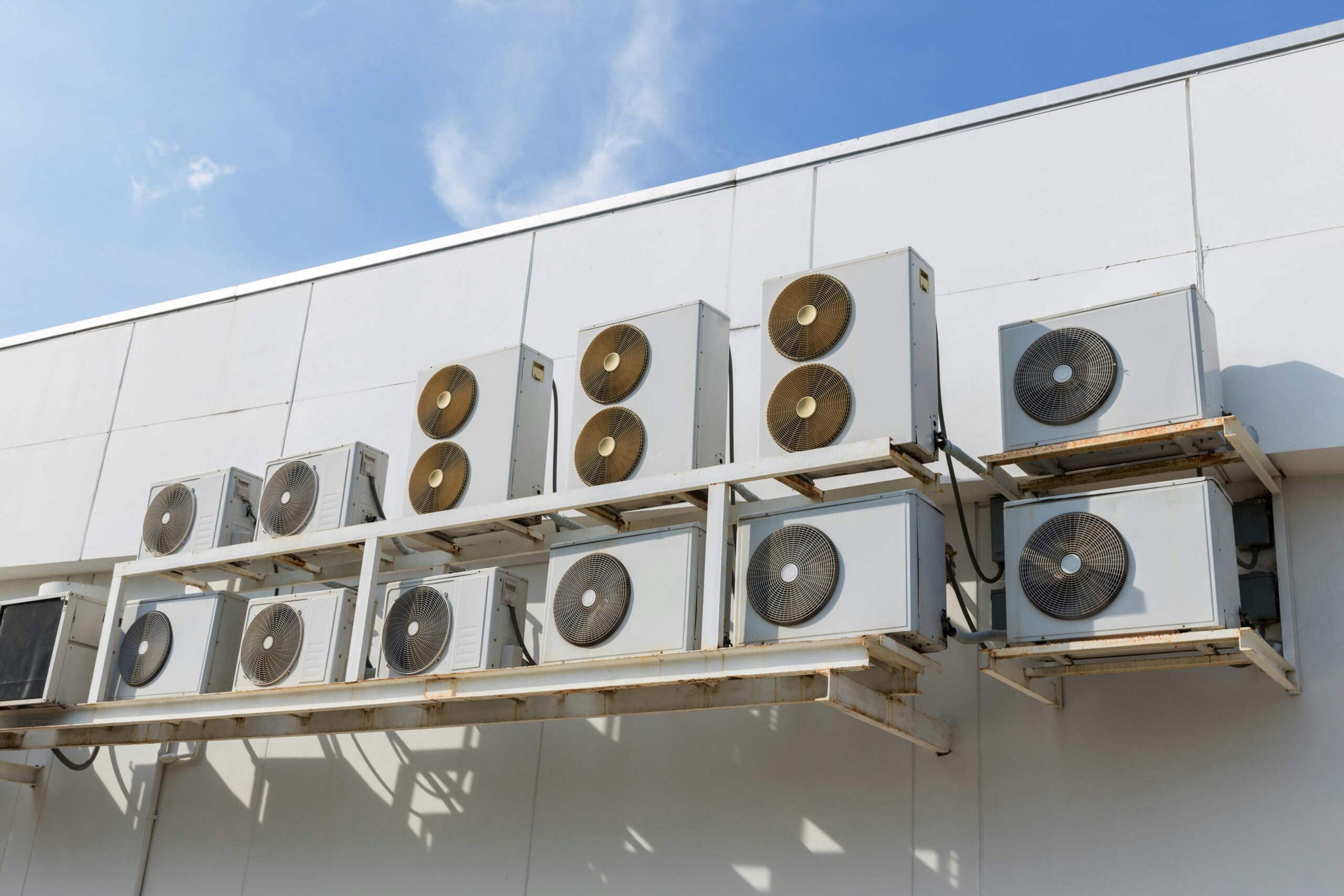
Trakref
Refrigerant Management: The Future Lies in a Team Approach

If you own any building or business in the United States, you are now host to a new set of responsibilities — because that unit likely contains high GWP refrigerants, including HFC refrigerants and maybe even some HCFCs and possible chlorofluorocarbons.
For the past 25 years, the business-as-usual approach to managing refrigerants has largely been reactive and focused on addressing immediate needs rather than proactively planning for long-term sustainability and compliance. This short-term was especially true in refrigerant management regulations, where the approach often involved fixing leaks, maintaining equipment on a break-fix basis, and using refrigerants without considering their environmental impact. And that makes sense: for much of the 1990s until maybe 5-10 years ago, we were much more focused on:
- Ozone-depleting substances
- Ozone layer
- Greenhouse gases overall
- Climate change as a broad concept
- The climate crisis
- Proper handling
We talked at a high level and found ideological dividing lines. We still spend a lot of time debating the impact of celebrity jets, for example — even though your average supermarket has a much bigger impact on the future of the planet.
Refrigeration has only had its moment in the past decade, and we’re still not fully there yet, although the AIM Act and new regulations are helping the discussions and focus along. Now we’re more inclined to discuss terms like:
- Air conditioners
- Refrigeration and air conditioning
- Chemical refrigerants
- How to manage refrigerants
- End-of-life recovery
- Cooling systems and various ways to handle cooling systems
- Refrigeration systems overall
- Project Drawdown
- Weak regulations vs. strong regulations
- Informational barriers to discussion
- Etc.
Organizations have tended to overlook the importance of regulatory compliance and the potential benefits of adopting energy-efficient technologies and processes. Consequently, this short-sighted strategy contributed to increased greenhouse gas emissions, inefficient resource utilization, and missed opportunities for enhancing overall operational performance and environmental stewardship.
The end of business as usual and new economic incentives
Maintaining a business-as-usual approach and disregarding regulations while adopting a defensive posture can hinder your organization’s success and affect your company’s ability to achieve compliance and meet your sustainability goals. Ignoring regulations and assuming a defensive posture can lead to several negative consequences:
1. Non-compliance penalties: By neglecting regulatory requirements, companies risk facing fines, legal actions, and potential operational restrictions, which can significantly impact their financial performance and overall reputation.
2. Missed opportunities for improvement: A defensive posture will continue to hide opportunities to optimize processes, reduce waste, and improve energy efficiency. This lack of proactivity has hampered achieving sustainability goals and reduced operational performance for decades.
3. Damaged brand reputation: In today’s environmentally conscious business landscape, companies that fail to prioritize compliance and sustainability risk tarnishing their brand image.
4. Increased operational costs: Ignoring regulations and failing to invest in environmentally friendly technologies or processes will result in higher energy costs and inefficient use of resources.
5. Hindered competitive advantage: Companies that do not prioritize compliance and sustainability are less competitive than those that embrace these values.
How to enhance your organizational focus on refrigerant management, compliance, sustainability, and more
Organizations must abandon the business-as-usual approach and actively engage in proactive control measures to address regulatory demands and environmental concerns to achieve compliance requirements and meet sustainability goals. By embracing a proactive mindset, companies can foster innovation, improve efficiency, and ultimately strengthen their competitive advantage in the market.
Establishing a refrigerant committee is an effective way to achieve compliance requirements and meet sustainability goals, enabling organizations to shift from a business-as-usual approach to a proactive strategy. By assembling a dedicated team of experts, companies can balance regulatory demands and environmental concerns, fostering innovation, enhancing efficiency, and ultimately bolstering your competitive advantage in the market.
Adopting a comprehensive refrigerant management strategy is crucial for various reasons. Firstly, it ensures that businesses comply with the ever-changing regulatory landscape, including federal regulations like the Clean Air and AIM Act, which focus on phasing out fluorinated substances. (This is all part of the idea of Project Drawdown.)
In addition, numerous state regulations and a growing set of requirements concerning PFAS controls and disclosures exist.
Secondly, it assists companies in reducing their scope 1 emissions, which includes direct greenhouse gas emissions from owned or controlled sources.
Lastly, it helps protect a company’s brand reputation by demonstrating a commitment to environmental preservation and corporate social responsibility. In this process, sustainability and compliance are the guiding principles, acting as the two bookends that frame and support the organization’s refrigerant management efforts.
To harmonize accounting with the demands of scope 1 reporting, organizations need to blend financial and environmental metrics. This requires combining scope 1 emissions data with accounting practices, encouraging teamwork between finance and sustainability departments, and using tools that enable precise tracking and reporting of financial and environmental performance indicators.
Building the team
Considering the critical need to adopt a comprehensive refrigerant management strategy, the logical next step is establishing a refrigerant management committee.
By assembling a diverse team of stakeholders, including asset managers (this is likely a new title), maintenance managers, contractors, facilities personnel, operations staff, HR representatives, legal advisors, dispatchers and or coordinators, engineering design, finance, customer service (sales), and engineers, a company can effectively address the various challenges and requirements associated with refrigerant management.
Your next refrigerant management program and the committee should be designed to provide effective governance over the entire process, ensuring that all aspects of the refrigerant management program are addressed efficiently and coordinated. This requires the committee to be flexible and adaptable in its approach, allowing it to keep pace with the rapidly evolving regulatory landscape, technological advancements, and best practices in the industry.
To achieve this, the committee should establish a robust governance framework that outlines each member’s roles and responsibilities and guidelines for communication, decision-making, communication, and monitoring progress. Regular meetings should be scheduled to review progress, discuss challenges, and identify opportunities for improvement. The committee should also remain informed about changes in legislation, industry trends, and emerging technologies and be prepared to revise its strategies accordingly.
The committee should be responsible for navigating the complex regulatory environment and chartered to ensure compliance with federal regulations like the Clean Air and AIM Acts, state regulations, and emerging PFAS controls and disclosure requirements. Additionally, the committee should be responsible for managing controls related to reducing scope 1 emissions, further emphasizing the company’s commitment to environmental sustainability.
The refrigerant management committee effectively sets the tone and cadence for achieving company objectives. Ensuring compliance, operations, and sustainability alignment, it fosters collaboration. It showcases the company’s dedication to the environment and social responsibility and its ability to balance stewardship with fiscal responsibility. This proactive approach enhances brand reputation, attracts eco-conscious customers and investors improves overall corporate image and performance.
The need for better views on sustainability
Sustainability is more than a mere marketing catchphrase; it should be the foundation and focus of your operational strategy.
In the past decade, companies have engaged in sustainability efforts related to clean air initiatives, recycling, and supporting eco-friendly causes, often without measurable value. However, the present landscape, characterized by regulatory demands, societal pressure, and technological advancements, has heightened the significance of sustainability in creating value for the entire organization.
Is sustainability deeply rooted in your operational strategy? To drive continuous improvement and enhance employee and customer loyalty, sustainability objectives should be central to your strategy and integrated into all change initiatives.
Studies indicate that incorporating sustainability into an organization can be challenging without a systematic and structured approach. Maintenance departments must embed sustainability goals into their asset management strategies, which should be data-driven and target operational capabilities, and enhance overall asset efficiency across the production process.
Fundamentally, a sustainable maintenance operation balances profitability, equipment downtime, loss and incident prevention, and deriving value from tangible assets. A sustainable operation is proactive, empowering employees and contractors to concentrate on prioritized tasks instead of adhering to a rigid schedule that disregards waste, safety, and efficient wrench time considerations.
Forming a refrigerant management committee is, therefore, not only a vital step for regulatory compliance and emissions reduction but also a strategic move for companies in today’s sustainability-balanced business landscape.
What’s the newest role on your team — the one you didn’t even know you needed?
Most of the roles mentioned already exist in your organization, but you may not have an asset manager or, specifically, an HVAC/R Asset Manager. This position is crucial in identifying, evaluating, and planning new opportunities within the heating, ventilation, and air conditioning systems, and refrigeration business sector. Some responsibilities would include:
Market analysis: responsible for staying informed about the latest industry trends, technologies, and regulations. This enables them to identify new opportunities for the organization to expand its offerings, improve efficiency, and increase profitability.
Technical expertise: They should be subject matter experts in HVAC/R systems and provide valuable insights into new opportunities’ technical feasibility, costs, and benefits. Their expertise helps guide decision-making when considering investments in new equipment, technologies, procedures or projects.
Financial planning: The HVAC/R Asset Manager should have some responsibility for evaluating the financial viability of new opportunities, including estimating costs, projecting revenues, and calculating return on investment. These include retrofits, replacement triggers, installation, and design changes.
Determine the best approach to manage and control refrigerant leak detection.
Project management: Once a new opportunity has been identified and approved, the asset manager may oversee its implementation, coordinating with various departments and stakeholders to ensure the project is managed, implemented, and executed efficiently and effectively.
Risk assessment: Identify and assess potential risks associated with new opportunities, such as regulatory compliance, environmental impact, and equipment reliability. Proactively addressing these risks can help the organization make informed decisions and minimize potential negative consequences. Determine an acceptable threshold for refrigerant leaks
The primary goals of a refrigerant management committee should be to align the refrigerant management program, processes, and procedures with the organization’s broader objectives and resources and facilitate the translation of strategic goals into tangible actions.
Wondering where to get started?
This is the chicken and egg scenario that counters fixing your governance against economic investment — which one should come first?
We all know that dispersed, uncoordinated policy implementation coupled with non-transparent siloed bureaucracies dominated by patronage and non-experts are the hallmark of “bad governance.” The World Bank studied this and found that it would be better to start with governance.
The World Bank found that weak institutions were functionally strong; we call this function over form. Although weak institutions do not cause improvements, they offer a pattern to adapt existing processes to solve particular problems.
Leveraging existing structures to form a refrigerant management team can lead to better outcomes by capitalizing on the functional strengths of these groups. Organizations can promote change and foster a more collaborative environment by adapting and improving current processes.
This approach allows for a more rapid transformation of processes leading to robust, efficient, and effective governance mechanisms implemented, ultimately contributing to success in improved regulatory compliance and sustainability performance.
Responsibilities of the refrigerant management committee
The refrigerant management committee should be responsible for your refrigerant management program and making a wide range of decisions that impact both tactical needs and long-term strategic objectives. Some of the key decision-making areas include:
Future Proofing your operation: Charge them with evaluating and selecting the most suitable technologies, systems, and practices to ensure the organization is prepared for the future. This may involve assessing alternative refrigerants with lower global warming potential, investing in energy-efficient equipment, or adopting new maintenance methodologies, or installing advanced refrigerant leak detection.
Tactical needs: The committee should develop a plan to secure a reliable and cost-effective supply of refrigerants, considering factors such as availability, regulatory compliance, and environmental impact. This may involve negotiating contracts with suppliers, exploring options for reclaiming and recycling refrigerants, or investing in refrigerant tracking and management software.
Repair versus replace: Ah, the two scenarios model. The committee must weigh the costs and benefits of repairing aging or leaking equipment against the investment in new, more efficient systems. This decision should consider factors such as age, maintenance history, energy efficiency, and the potential impact on operations and emissions.
Balance reactive and preventive maintenance options: To minimize equipment downtime and reduce emissions, the committee should explore options for transitioning from a break-fix maintenance approach to a more proactive, preventive strategy. This may involve implementing regular equipment inspections, adopting condition-based monitoring, and investing in training and resources for maintenance personnel.
Finding additional budget resources(more on this later): The committee must identify opportunities to secure additional funding for investments in preventive maintenance, equipment upgrades, and other initiatives that support the organization’s refrigerant management objectives.
This may involve reallocating resources from other areas of the business, seeking grants or incentives from government programs, or demonstrating the financial benefits of the proposed investments through cost savings, improved efficiency, and reduced emissions.
By addressing these critical decision-making areas, the refrigerant management committee can help the organization navigate the complex landscape of the refrigerant management program and drive continuous improvement in its operations, emissions reduction, and overall sustainability performance.
More than just a material tracking committee
The responsibilities are clear, but what spectrum is this committee responsible for managing? To keep things simple, one pound of refrigerant = one ton of carbon. So if you are an average business, your refrigerant leak rates are likely costing you more than your maintenance spend when considering the social cost of carbon.
The social cost of carbon (SCC) is an estimate of the cost, in dollars, of the damage done by each additional ton of carbon emissions. It also estimates the benefit of any action taken to reduce a ton of carbon dioxide equivalent emissions.
The social cost of carbon directly impacts air conditioning and refrigeration budgets as it assigns a monetary value to the environmental consequences of using refrigerants with high global warming potential (GWP). By incorporating this metric, a refrigerant committee can make more informed decisions about equipment investments, maintenance practices, and your overall refrigerant management program.
Considering the social cost of production of carbon dioxide in your decision-making and authority provides a full life cycle cost for refrigerants:
Prioritize investments in low-GWP refrigerants (avoiding high-GWP HFC refrigerants) and energy-efficient air conditioning systems that reduce greenhouse gas emissions, lowering the organization’s social cost of carbon and associated financial risks.
Refrigerant Leaks are costly: Consider that a 5 LB HFC refrigerants leak @ the present IWG (Interagency working group) value of $51 is $255. But in the open market, we see prices of $100 US per ton in Europe.
Europe is a market that will matter more as we approach CBAM (2026), the Carbon Border Adjustment Mechanism – be on the lookout for a story on this in the next few months.
If you’re retrofitting to a new refrigerant, this committee should consider the carbon impact on the balance sheet.
Special opportunities are available today for developing carbon offsets or even carbon insets for companies making strategic investments in a combined refrigerant management and refrigerant leak detection system. Applying the SCC to avoid leaking high global warming potential HFC refrigerants helps leverage new resources to make added investments like this.
Add in the cost of the carbon related to installation and potential savings from refrigerant leaks when determining the replacement or retrofit of your system from high GWP refrigerants to a lower carbon equivalent. For instance, switching from R-410 to R-32 will reduce your footprint by 1215 pounds of carbon per pound of refrigerant installed.
By considering the social cost of carbon, the refrigerant committee can make better-informed decisions by leveraging the total lifecycle costs of refrigerant and providing the added lift needed to understand the long-term financial risks better and help your finance team create a complete understanding of the impacts from Mobile and Stationary Air conditioning systems, refrigeration and process cooling assets.
This is all about making sustainability a reality
The shift to modern technology has been underway for decades, and it is vital for replacing reactive time or failure-based maintenance strategies./. Any organization that can incorporate data and modern technology better to understand the current operating condition of its assets can also minimize losses, but what do you do with the data?
Without a plan and a team to hold themselves accountable, this data will likely end up on the cutting room floor and fail to provide you with any useful value.
Every time I talk to someone, they want to know what to do to tackle the refrigerant leak problem, and in most cases, they hope I tell them about a widget they can install, and all their problems will go away. There is no silver bullet or advanced AI widget, but some cool tools can help, and your committee should screen them.
After 14 years of working with refrigeration teams all over the US and many parts of the globe and 30 years of working with processing cooling companies, it is our conclusion after many years of experience that your team needs to establish a committee that has governance over the entire process and then empowers them to build a culture focused on solving the myriad of problems that have led to a culture of avoiding fixing the refrigerant leaks.
Operationalizing refrigerant management, compliance, and sustainability
Trakref is a powerful team solution for organizations aiming to effectively manage refrigerant assets, streamline compliance, and support sustainability goals. As a comprehensive refrigerant management software system, Trakref was designed to serve as a central hub for information and reporting required by regulators and auditors by leveraging data from maintenance teams and contractors and applying a unique asset taxonomy and rules guidance system.
Trakref, as a product, addresses the refrigerant challenge effectively and fosters collaboration, increased visibility, and engagement across entire organizations. When combined with Fexa.io, the result is a cohesive platform that ties financial performance together with environmental regulations and can act as the single point of truth that supports all the roles mentioned and ensures seamless communication and cooperation among teams involved, eventually leading to improved refrigerant management, compliance, and sustainability outcomes.
By utilizing Trakref, organizations can optimize their refrigerant management strategies, improve compliance, and work collectively towards a more sustainable future.
A refrigerant management charter and the decision-making ability to avoid emissions
Compliance and sustainability teams can influence maintenance budgets, but they often face challenges in changing the course of maintenance teams’ operations. This is mainly because the culture has been historically focused on break/fix approaches, leading executives to believe that disrupting this model will reduce profitability and effectiveness.
To overcome this barrier, it is crucial to demonstrate the long-term benefits of proactive maintenance strategies and their alignment with sustainability and compliance goals, ultimately leading to enhanced operational performance and a stronger competitive advantage.
A shared vision and approach
Mobile and Stationary Air conditioning systems and refrigeration significantly impact facility costs, energy expenditures, and environmental footprint, accounting for 30-50% of these aspects. To address this, operations, maintenance, compliance, sustainability, client services, facilities, engineering, and finance teams must collaborate and develop a shared vision and approach to refrigerant management.
Multiple regulations exist at state, federal, and international levels, accompanied by growing shareholder concerns about environmental impact. Once overlooked, refrigerant emissions are now becoming more visible, with the lifecycle of refrigerant molecules appearing on companies’ balance sheets worldwide. Adopting a committee structure represents an evolutionary step in the market’s maturation process as the industry shifts from avoiding the issue to actively engaging in sustainable solutions.



